In Santa Barbara’s rarefied world of orchid breeders, Paul Gripp is as close as you can get to royalty, and today he’s doing what he loves best: holding forth at the storied nursery he helped create — Santa Barbara Orchid Estate.
At 90, Gripp is slender and spry, yanking weeds that flourish in the nursery’s dark soil or dragging heavy fronds from its forest of palms to a pile for disposal. His memory is sometimes hazy about life events — “I’m so old I don’t remember how old I am,” he jokes — but if you want to talk orchids, Gripp is still your man.
For the record:
12:00 p.m. March 2, 2023Paul Gripp served in the Navy after the Korean War, not during the war as was incorrectly stated in an earlier version of the story.
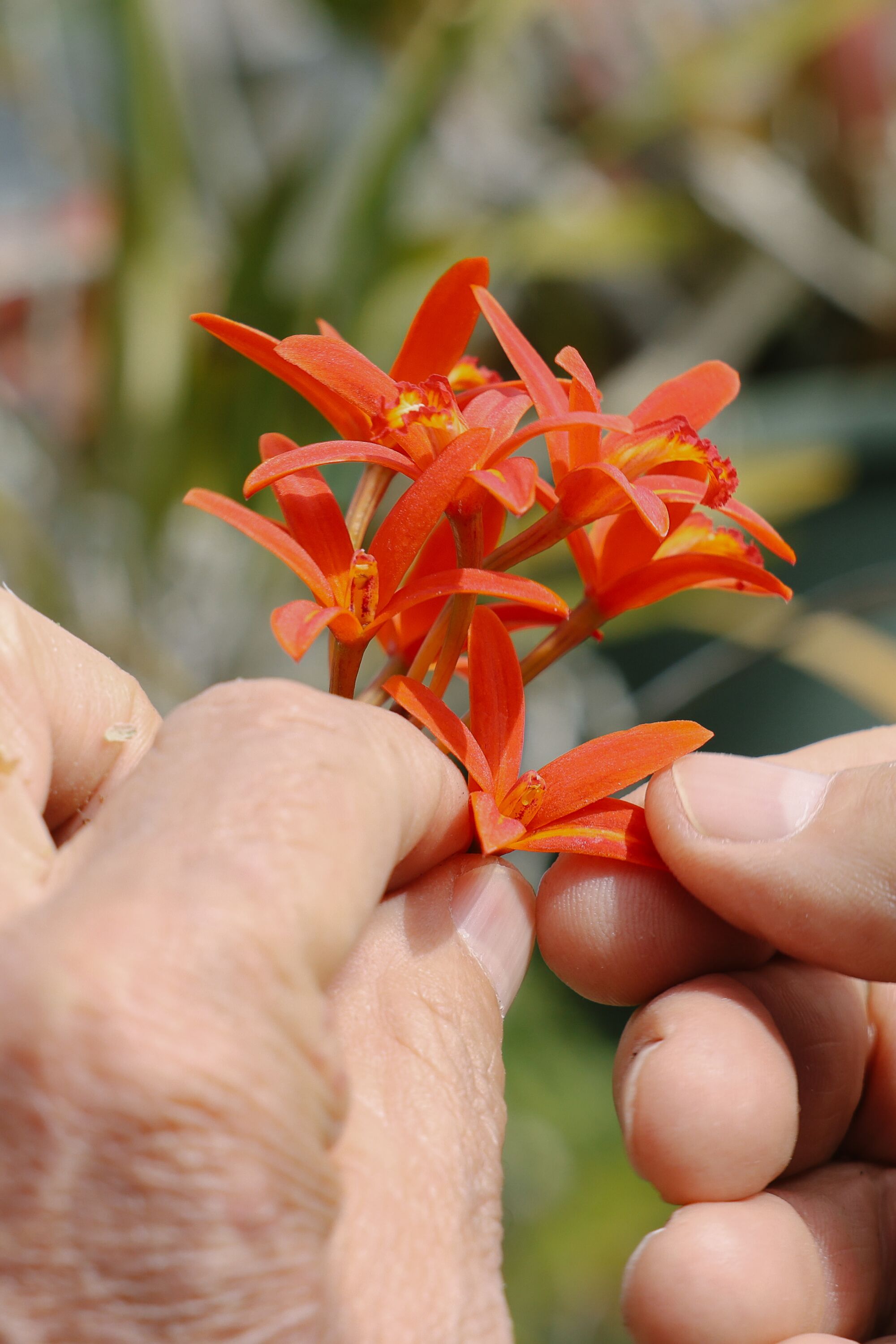
SBOE’s hybridizer Randall Umland touches an orchid he used to make a new cross, but he must wait several years to see if it produces anything worth selling.
(Dania Maxwell / Los Angeles Times)
“Working in orchids has been like living in a dream,” he said. “There’s thousands of different kinds, and I got to travel all over to find things people would want. But the first orchid I found? It was in Topanga Creek, Epipactis gigantea, our native orchid, and you can still find them growing in [California’s] streams and canyons today.”
Orchids became the main focus in Gripp’s life in 1957, when he moved to Santa Barbara to help his wealthy employer, Robert J. Chrisman, create the nursery, also known as SBOE, to grow and sell orchids. He managed the nursery, and purchased it after Chrisman, a former insurance executive, died in 1965.
Gripp also published regular articles about orchids and became a popular speaker, promoting his nursery and Santa Barbara’s famous community of orchid growers along the way. And like many of those orchid breeding pioneers, he regularly traveled the world — to the Philippines, Myanmar (then known as Burma), India, the high Andes, Mexico, Guatemala, Brazil and New Guinea — collecting unusual orchids and fostering exchanges with international growers.

Local artist Randall Umland does the breeding these days, using a toothpick to spread pollen from one candidate to another hoping to create a beautiful hybrid,
(Dania Maxwell / Los Angeles Times)
He said he traveled so much he sometimes led tours. “I’m one of the few guys you’ve ever talked to who’s looked down at Mt. Everest from the cockpit of an airplane,” he said. “That’s because I was the leader of a tour, so the pilots would let me sit in the cockpit. We’d go looking for orchids in Darjeeling [in the eastern Himalayas in India] at about 10,000 feet, and they’d issue you a little chunk of coal to put in your heater in the hotel room to keep from freezing to death. And that was how we’d make our living.”
At the time, serious orchid growers in the U.S. were usually retired wealthy hobbyists with greenhouses. But orchids grew outdoors all over the world, Gripp said, so he thought why not cultivate varieties that would grow in California’s mild coastal climates and breed those orchids with other varieties to create sturdy, unusual hybrids that could thrive outside?
“I’d bring back 50 orchids and a lot of them didn’t live very long [outside],” Gripp said. “But those that did, I’d cross. It was a way of making money, and I think we did pretty good.”
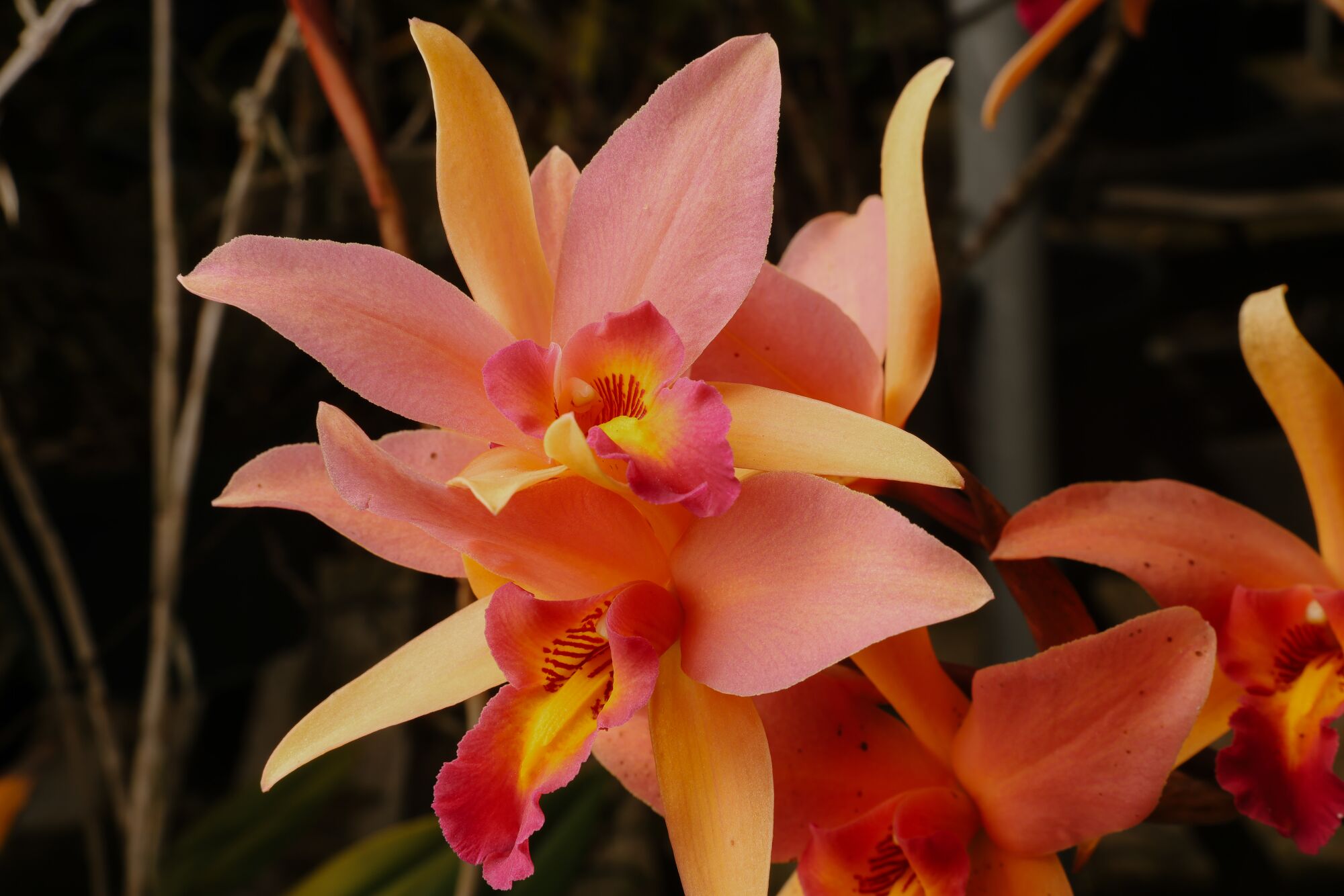
The Santa Barbara Sunset is one of the standout orchids Paul Gripp bred at the Santa Barbara Orchid Estate.
(Dania Maxwell / Los Angeles Times)
It’s hard not to be goggle-eyed at all the hundreds of varieties and colors at SBOE, but one particiular winner created at SBOE stands out: Santa Barbara Sunset, a striking Laelia anceps and Laeliocattleya Ancibarina cross with rich salmon, peach and magenta hues that can live happily outside in California’s warmer climes and is still a top seller.
“People flocked for the experience of walking around that nursery and learning things from him,” said one of his former employees, Lauris Rose, now president of the Santa Barbara International Orchid Show and co-owner of Cal-Orchid Inc., a neighboring nursery.
“Paul lectured all over the world, teaching people about different species of orchids in a very accessible way. He didn’t act like a professor. He got up there with anecdotes like, ‘One time I climbed up this tree trying to reach a plant in another tree, and all these red ants infested my entire body, so I had to take off all my clothes and rub all these ants off my body,’” she said. “A lot of people’s lectures are boring as dirt, but Paul could command a room. He had charisma and it was infectious.”
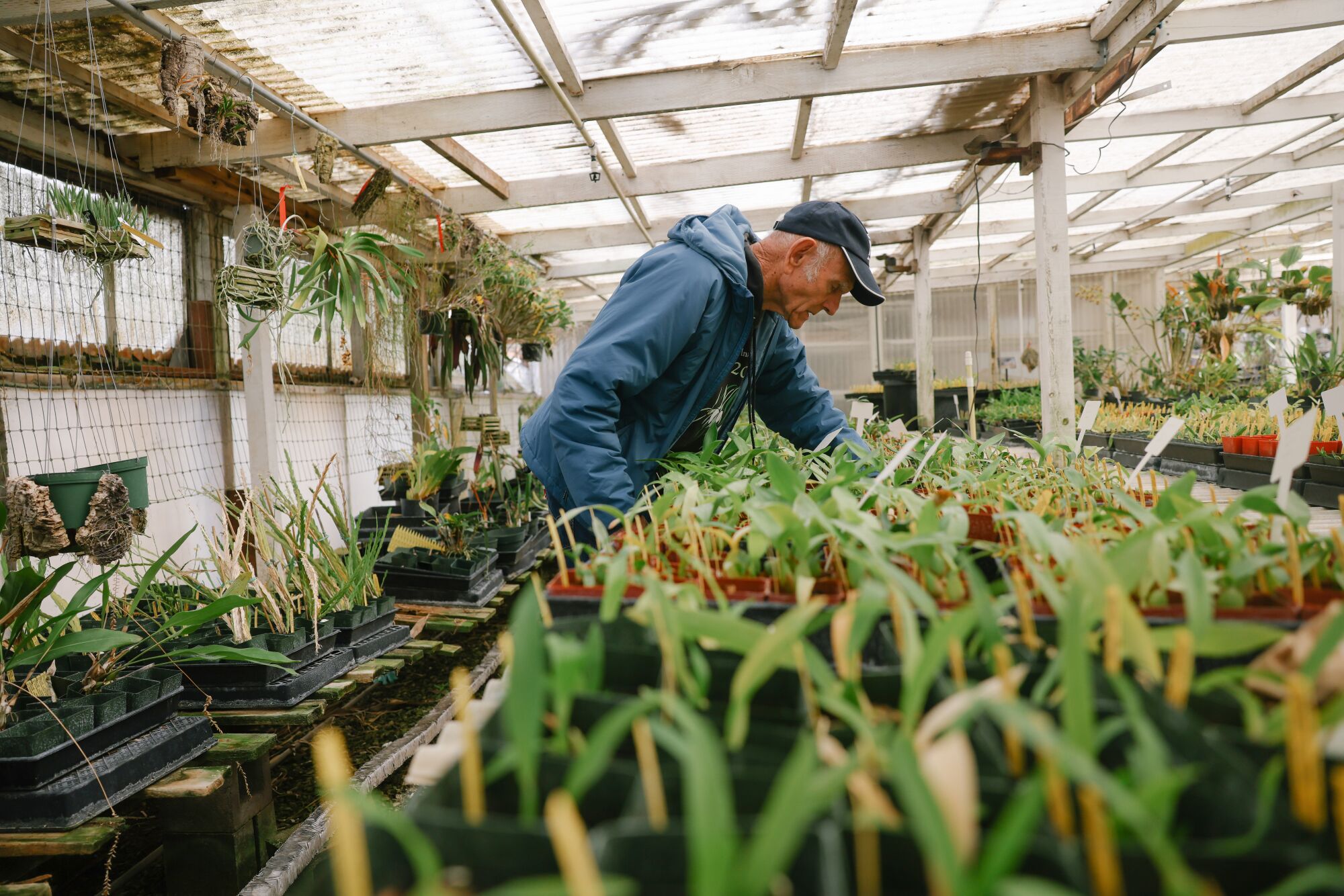
Paul Gripp was instrumental in bringing the Santa Barbara International Orchid Show to prominence, and it will have its 75th show March 10 to 12.
(Dania Maxwell / Los Angeles Times)
SBOE now is owned by his children, Alice and Parry Gripp, and Alice runs the operation. But her dad still comes by regularly to help with repotting, weeding and answering customer questions, which is why he’s going to be a fixture at the nursery March 10-12, when the 75th Santa Barbara International Orchid Show resumes after a three-year, COVID-induced hiatus.
The show attracts 8,000 to 10,000 orchid enthusiasts every year to the Earl Warren Showgrounds, “the only venue in Santa Barbara large enough to hold us,” said Rose. The prestigious show expects to have at least 24 exhibitors and vendors from California, Hawaii, Florida and Minnesota, as well as Ecuador, Peru, Colombia, Taiwan and Thailand, along with free workshops about orchids and their care from 10 a.m. to 5 p.m. each day.
But one of the show’s biggest draws is outside the fairgrounds — the California Orchid Trail, a map that leads visitors to SBOE and five more of Santa Barbara County’s premier orchid nurseries.
SBOE will share a booth at the show, but Alice expects the real action to be at the nursery, which, like all the other nurseries on the trail, will have extended hours during the show to accommodate the crowds of gawkers and buyers. Customers always seek out Paul for his endless orchid stories and advice, said Alice, and he is always happy to oblige.
“Paul loves plants, but what he loves most in life is teaching other people about orchids,” Alice said. “He chats with them, and I try to take their money.”
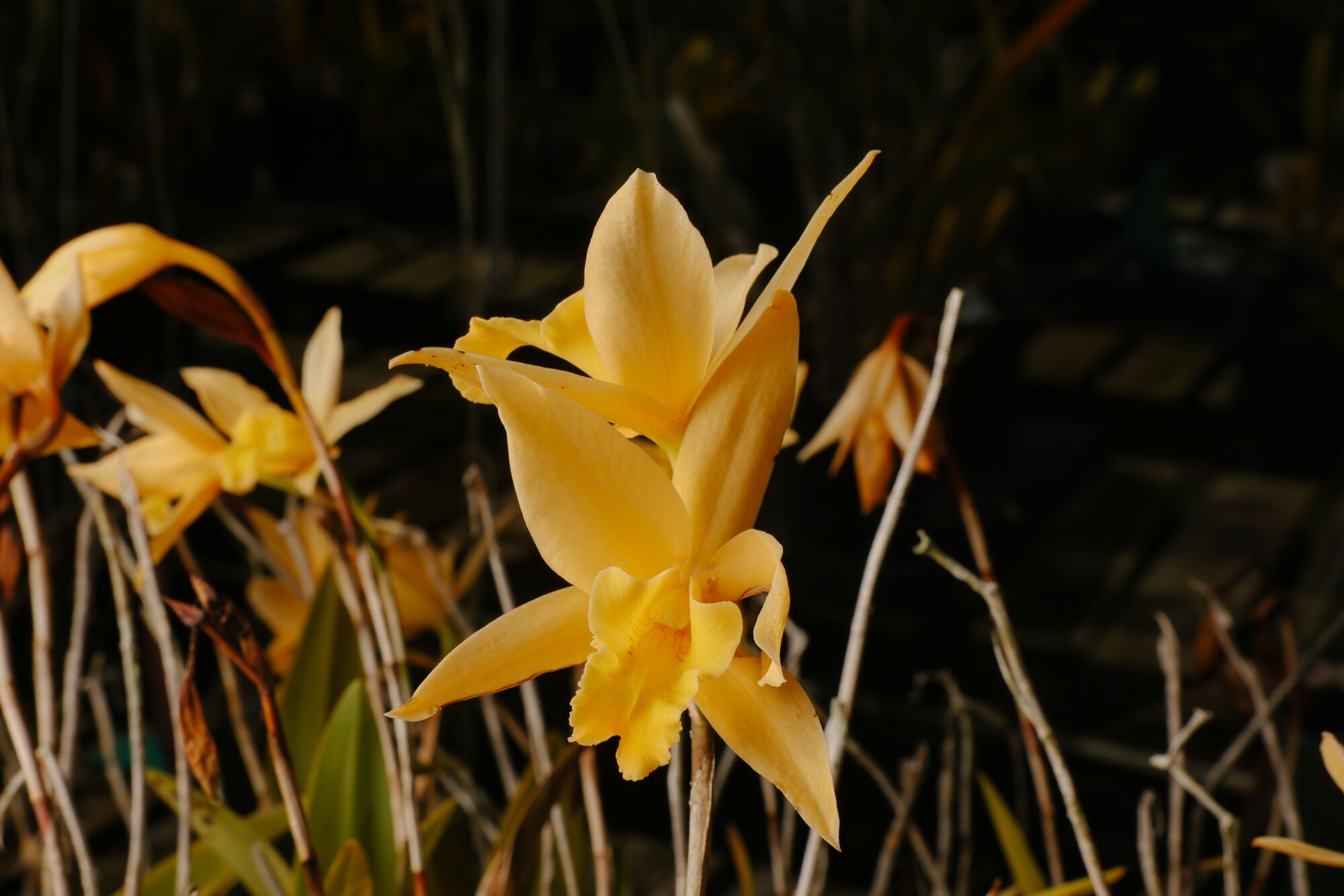
A Laelia Canariensis at the Santa Barbara Orchid Estate.
(Dania Maxwell / Los Angeles Times)
When Paul and his then-wife Anne Gripp divorced in 1986, Paul kept his oceanfront house with its breathtaking view of the Pacific, and Anne got SBOE. Her children inherited the nursery after Anne died, and they took over its operation in 1994. But Alice is camera-shy and determined to let her dad promote the nursery while she works in the background.
Paul is officially retired, but he still comes to the nursery a few times a week to help divide plants or weed. “Alice is doing a terrific job. She has to keep track of all this stuff,” he said waving his hand around the greenhouse. “Me, I like to work, so I work for nothing. I just try to help out.”
If you ask Paul to name his favorite orchid, he’ll take you on a tour of the nursery’s sprawling greenhouse pointing out a series of beauties, but he never lights on one.
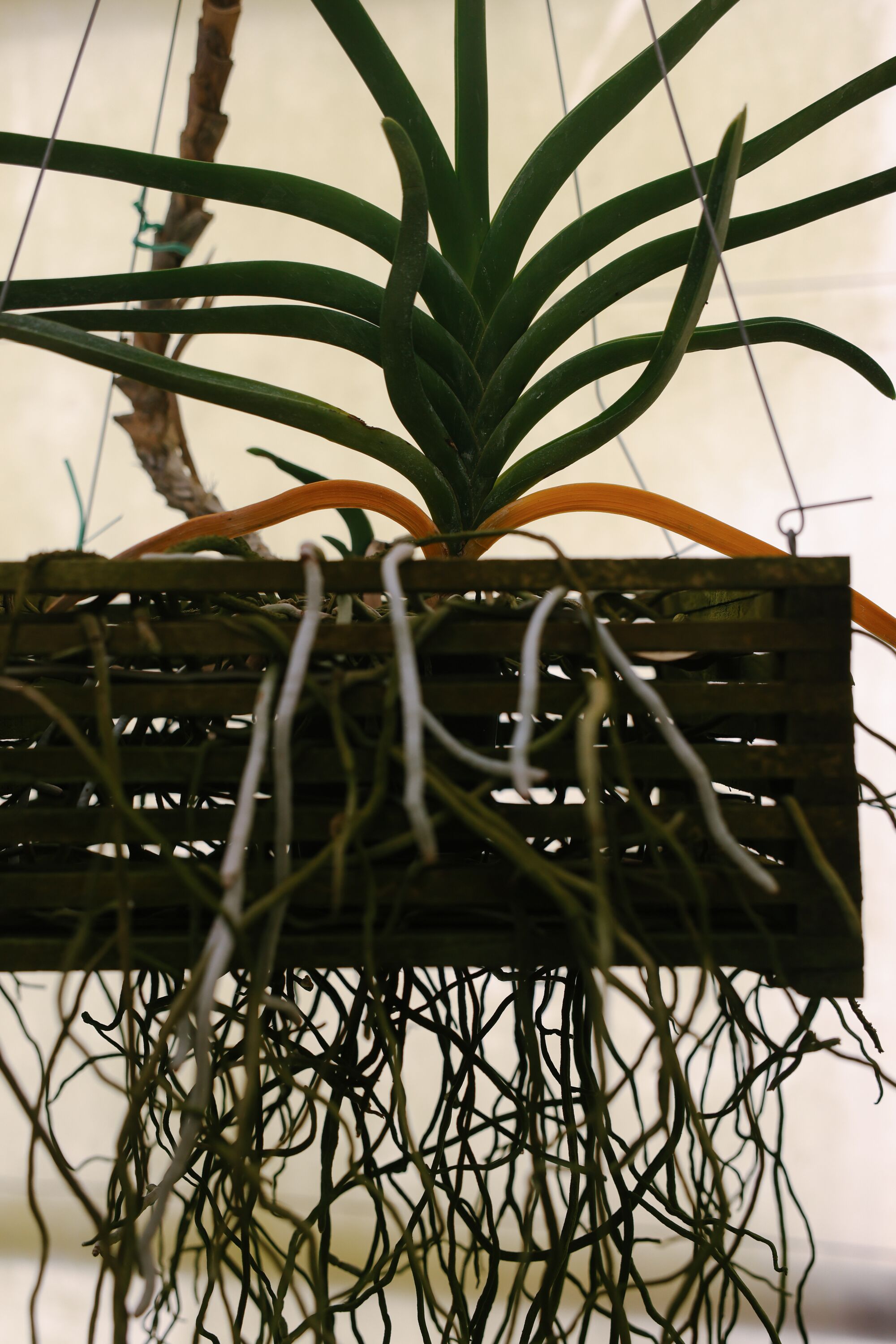
An orchid grows at the Santa Barbara Orchid Estate on Tuesday, Feb. 21, 2023.
(Dania Maxwell / Los Angeles Times)
“He used to say, ‘I’m an orchid man. I love every orchid equally,’ and he does,” Alice said. “I don’t know if he would run into a burning building to save a Phalaenopsis from Trader Joe’s, but he told me once, ‘I’ve never thrown out a plant’ and that’s probably true. When he was running things, the aisles were so crammed people were always knocking plants off the benches because they couldn’t walk through.”
Paul grew up around Topanga Canyon, where he discovered his first orchids growing in the wild. He went to Santa Monica College and then UCLA, where he earned a degree in horticulture, and worked as a gardener on weekends, primarily for Chrisman, a hobbyist orchid owner who lived in Playa del Rey.
“I’d follow him around and help him get things done,” Paul said. “I mowed his lawn, I’d take care of his house when they went on vacation and I bought their Christmas tree. Anything he wanted, I did. I was a very loyal employee.”
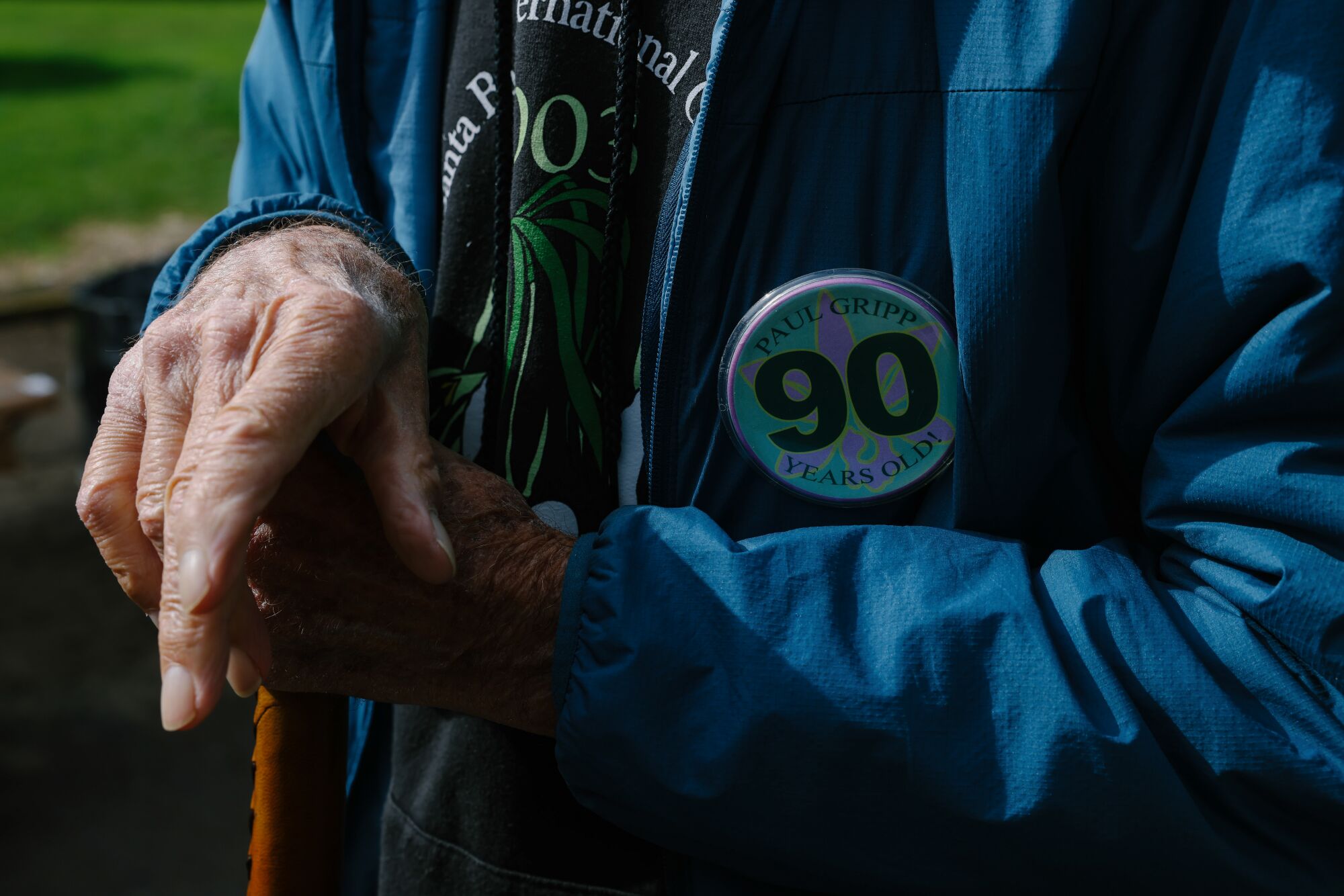
Paul Gripp’s memory is sometimes hazy about life events — “I’m so old I don’t remember how old I am,” he jokes — but if you want to talk orchids, Gripp is still your man.
(Dania Maxwell / Los Angeles Times)
He finished his degree, then served in the Navy after the Korean War, and when he got out, one of the first people he called was “Mr. Chrisman” — even today, Paul always refers to his former employer as Mr. Chrisman.
“I just said, ‘I just got discharged from the Navy’ … I didn’t ask for a job, but he liked me, I think, and he said, ‘OK, why don’t you go to Santa Barbara, because I’ve bought this land there, and we can start a nursery.’”
SBOE didn’t just spawn new orchid varieties — it was the birthplace for two other prominent orchid nurseries. Rose — then Lauris Hawkins — met her husband, James, in the 1970s when they were both working at SBOE. James was the hybridizer who helped Gripp create many of the nursery’s famous orchids and now he and Lauris own Cal-Orchid Inc. just across the road from SBOE. And Jim and Noelle Burkey, owners of Orchids Royale in Carpinteria, met and fell in love while they were working at SBOE.
Like all worlds where a small group share an esoteric passion, intrigues and rivalries abound in Santa Barbara’s orchid world, but Lauris Rose remembers a real camaraderie in those early days at SBOE.
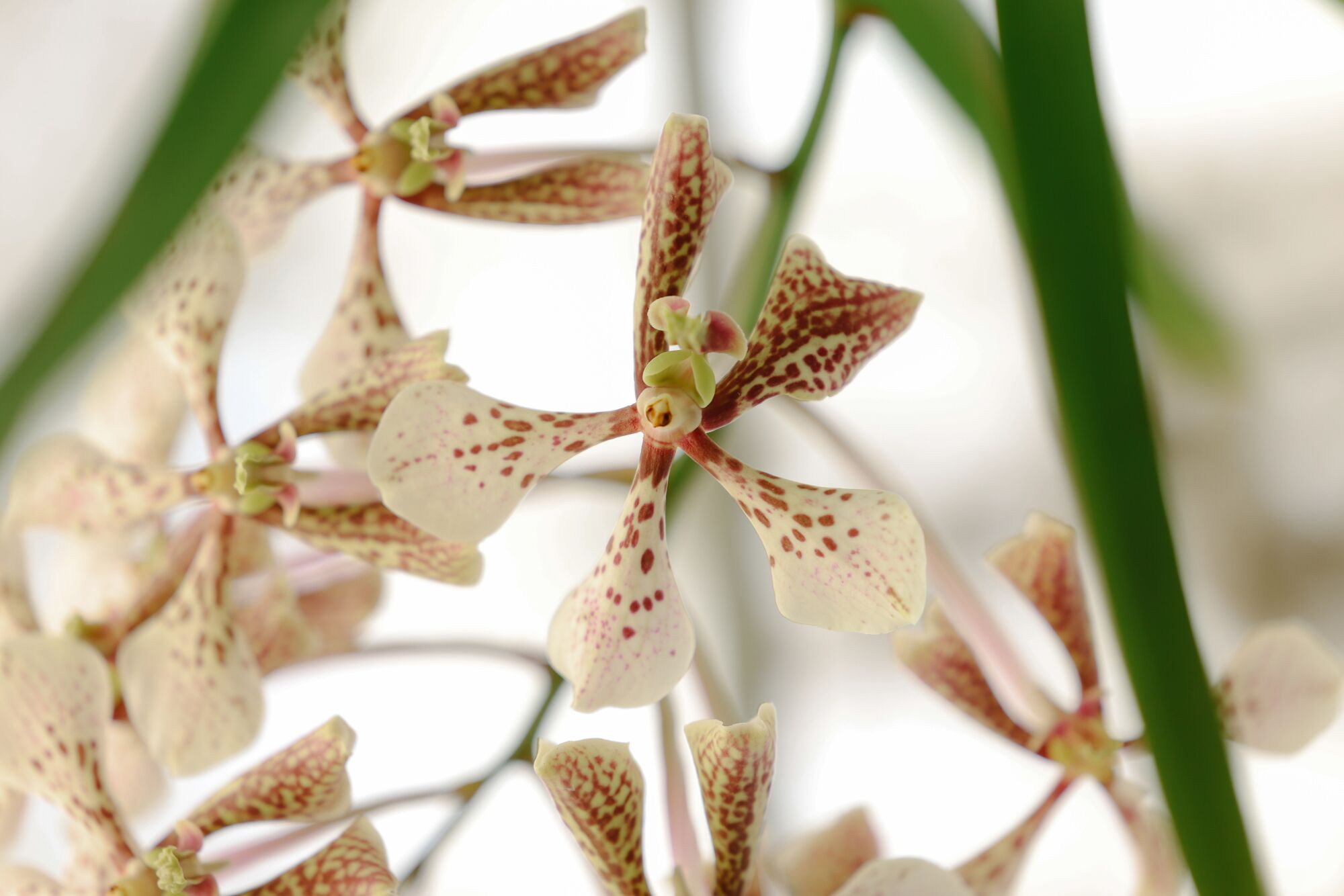
Vanda Ellen Noa, an old variety first registered on Jan. 1, 1946, grows at the Santa Barbara Orchid Estate.
(Dania Maxwell / Los Angeles Times)
“They weren’t just selling orchids; they were launching a healthy respect and love in their workers,” she said. “Even the people who didn’t last long loved every minute of working there, and when they had to leave, for whatever the reason was, they cried. That’s how deep it all goes in all of us.”
After 66 years, SBOE is still lush with exotic plants, but you can see its age in the greenhouse’s weathered benches and posts and in the tall forest of palms, fruit trees, succulents and shrubs on the grounds. Local artist Randall Umland does the breeding these days, using a toothpick to spread pollen from one candidate to another, hoping to create a beautiful hybrid but having to wait for years to see any results. “The job requires patience,” Umland said, smiling.
There’s bits of history at the nursery too; like the fading photo of the meeting between the Dalai Lama and the president of UC Santa Barbara in 1991, with SBOE’s beautiful orchids decorating the stage. And outside one of the greenhouses, securely attached to a tall dead sequoia stump, is the first orchid that Chrisman purchased for himself in 1947 at a Thrifty Drug Store in Beverly Hills, a hardy Laelia anceps from Mexico with pale violet blooms — the plant, Paul said, that started it all.
But while nursery staff is happy to answer questions from buyers, don’t bring your flagging Trader Joe’s moth orchid to the nursery for a tuneup. These indoors-only Phalaenopsis orchids are ubiquitous at Trader Joe’s and other markets, but “we’re not orchid doctors,” Alice said. “We’ve wasted tons of time with people who never even buy from us, and I have to tell them, ‘Please don’t bring your diseased plants with bugs to my nursery.’”
Paul said, simply, that Phalaenopsis orchids are good for indoors, but don’t expect them to live very long. “A house is a house, not a jungle,” he said, “so there’s a 99% chance they’re going to die. But they’re pretty cheap [to buy], so it works out pretty good.”
SBOE doesn’t even sell Phalaenopsis anymore, Alice said. “I just send people to Westerlay Orchids in Carpinteria, because they have a beautiful selection with lots of colors. SBOE caters to a more experienced crowd, willing to pay top dollar for extraordinary outdoor blooms.
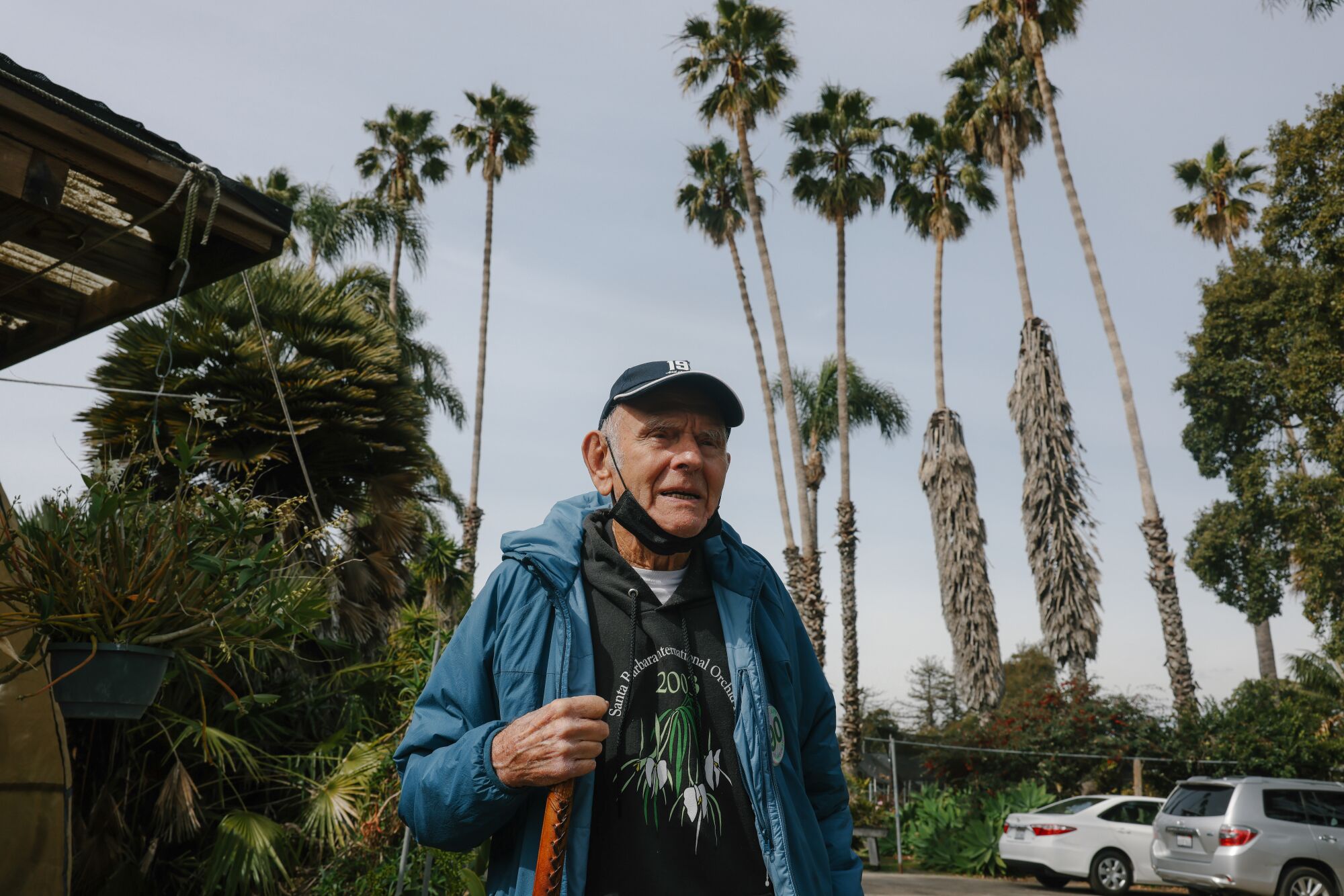
After serving in the Navy, Paul Gripp helped establish the Santa Barbara Orchid Estate.
(Dania Maxwell / Los Angeles Times)
“I read a review [of the nursery] that said, ‘Don’t come here if you don’t want to learn about orchids. They don’t want people who don’t want to learn anything,’ and that’s totally fair,” Alice said. “We ask a lot of questions so you don’t try to grow your first orchid in the wrong conditions. We always say, ‘There’s an orchid for every person,’ although sometimes it’s a silk one from Michaels.”
So if you’re ready to amaze your friends with orchids that bloom on your patio or hanging from a tree, Paul Gripp will be glad to share his advice. And you can capture a little of that orchid hunter lore while he’s still around to share.
“Those were the glory years, and I’m glad I was part of it,” Lauris Rose said. “I was in my 20s — I’m 72 now — but all those orchid guys, Paul, even my husband, were million-milers with the airlines. There was passion and romance and knowledge, a dynamic state of knowledge, and everything was changing about how we bred. You had to travel and meet with people at least every six months, just to keep up.
“Breeding orchids, it’s not wacky,” she said. “It’s not a cult. It just gets in your soul.”

Orchids line the greenhouse at the Santa Barbara Orchid Estate.
(Dania Maxwell / Los Angeles Times)
Stay connected with us on social media platform for instant update click here to join our Twitter, & Facebook
We are now on Telegram. Click here to join our channel (@TechiUpdate) and stay updated with the latest Technology headlines.
For all the latest Fashion News Click Here
